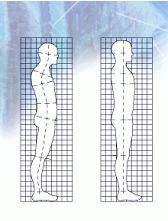
Copyright 2018 Alice Billman CA Cert #1933 (562) 708-1202
What Are Connective Tissue And Fascia?
Any tissue in the body that has a connecting function is considered to be connective tissue. Tendons, ligaments, and even blood are connective tissue. The form of connective tissue that Hellerwork primarily affects is called fascia. Fascia is a plastic-like tissue that wraps all of the muscles, and all of the individual fibers and bundles of individual fibers that become muscle. Fascia comes together at the end of the muscle and becomes the tendon, which attaches the muscle to the bone.
The fascial system of our body can be seen as a multi-layer body stocking, with fascial sheaths wrapping the muscles and weaving in layers throughout the body. Because of this, stress in any area of the body has an effect on every other part of the body. For instance, tension in the connective tissue of the leg pulls the tissue throughout the torso.
In its optimal condition, fascia is a loose, moist tissue. When there is continual loose movement and balance in the body, the fascial body stocking stays loose and mobile, facilitating the movement between different parts of the body. However, under continual stress and lack of movement, fascia becomes rigid and loses its fluidity. Layers of fascia begin to glue to one another, causing the '"knots" you may have experienced in your back or neck. The sheaths of fascia stick in a systematic way, based on our habitual patterns of movement, or more correctly, lack of movement. Although people most often associate tension and stiffness with their muscles, it is actually the connective tissue that accumulates much of this stress.
What Do Gravity And Alignment Have to Do With Hellerwork?
Gravity is the force that pulls any two masses together, notably the earth and our human bodies. We learn about this force early in life, but then get used to it, although it continually pulls on us. Alignment simply means that things are in a straight line. If items are in a zig-zag pattern, we would say that they are out of alignment. In Hellerwork, the main direction of alignment that we consider is vertical alignment - are the body's segments stacked in a straight line from the ground up, or are they at a tilt, or perhaps a zig-zag.
If a body or structure of any kind is vertically aligned, gravity is a benign and positive force - it keeps us on the planet! It also supports us in being balanced. An imbalanced body, however, feels gravity as a stress. Consider two buildings. The balanced and erect building has no problem with gravity. Gravity is the force that makes the earth a foundation for the building in the first place. The leaning tower of Pisa, however, is stressed by gravity. Since it is already imbalanced, gravity works to pull it down.
It is the same with our bodies - if they are aligned, gravity is supportive. If they are out of alignment, gravity becomes a primary force that is felt by our bodies as a demand to tense up and hold on!
Your Hellerwork Practitioner
Hellerwork Practitioners are a unique group of health educators. They have all received extensive training in Hellerwork. They are individuals who are committed to actualizing the principles of Hellerwork, not only in their Hellerwork sessions, but in their personal lives.
These principles include the results easily visible in the Hellerwork series: body alignment, fluid movement, and the free flow of energy in the body. Practitioners are equally committed to less visible principles - relationships that are filled with true rapport, self-expression, and free flowing communication. Hellerwork Practitioners practice the true meaning of responsibility - the ability to respond. It is these characteristics that make your Practitioner unique.
Any tissue in the body that has a connecting function is considered to be connective tissue. Tendons, ligaments, and even blood are connective tissue. The form of connective tissue that Hellerwork primarily affects is called fascia. Fascia is a plastic-like tissue that wraps all of the muscles, and all of the individual fibers and bundles of individual fibers that become muscle. Fascia comes together at the end of the muscle and becomes the tendon, which attaches the muscle to the bone.
The fascial system of our body can be seen as a multi-layer body stocking, with fascial sheaths wrapping the muscles and weaving in layers throughout the body. Because of this, stress in any area of the body has an effect on every other part of the body. For instance, tension in the connective tissue of the leg pulls the tissue throughout the torso.
In its optimal condition, fascia is a loose, moist tissue. When there is continual loose movement and balance in the body, the fascial body stocking stays loose and mobile, facilitating the movement between different parts of the body. However, under continual stress and lack of movement, fascia becomes rigid and loses its fluidity. Layers of fascia begin to glue to one another, causing the '"knots" you may have experienced in your back or neck. The sheaths of fascia stick in a systematic way, based on our habitual patterns of movement, or more correctly, lack of movement. Although people most often associate tension and stiffness with their muscles, it is actually the connective tissue that accumulates much of this stress.
What Do Gravity And Alignment Have to Do With Hellerwork?
Gravity is the force that pulls any two masses together, notably the earth and our human bodies. We learn about this force early in life, but then get used to it, although it continually pulls on us. Alignment simply means that things are in a straight line. If items are in a zig-zag pattern, we would say that they are out of alignment. In Hellerwork, the main direction of alignment that we consider is vertical alignment - are the body's segments stacked in a straight line from the ground up, or are they at a tilt, or perhaps a zig-zag.
If a body or structure of any kind is vertically aligned, gravity is a benign and positive force - it keeps us on the planet! It also supports us in being balanced. An imbalanced body, however, feels gravity as a stress. Consider two buildings. The balanced and erect building has no problem with gravity. Gravity is the force that makes the earth a foundation for the building in the first place. The leaning tower of Pisa, however, is stressed by gravity. Since it is already imbalanced, gravity works to pull it down.
It is the same with our bodies - if they are aligned, gravity is supportive. If they are out of alignment, gravity becomes a primary force that is felt by our bodies as a demand to tense up and hold on!
Your Hellerwork Practitioner
Hellerwork Practitioners are a unique group of health educators. They have all received extensive training in Hellerwork. They are individuals who are committed to actualizing the principles of Hellerwork, not only in their Hellerwork sessions, but in their personal lives.
These principles include the results easily visible in the Hellerwork series: body alignment, fluid movement, and the free flow of energy in the body. Practitioners are equally committed to less visible principles - relationships that are filled with true rapport, self-expression, and free flowing communication. Hellerwork Practitioners practice the true meaning of responsibility - the ability to respond. It is these characteristics that make your Practitioner unique.

Before After
HELLERWORK

